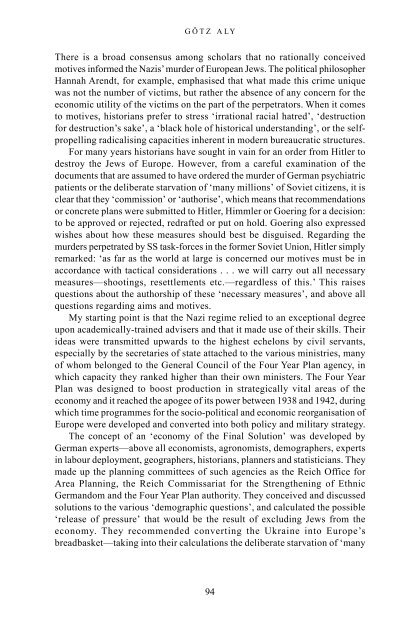The_Holokaust_-_origins,_implementation,_aftermath
The_Holokaust_-_origins,_implementation,_aftermath
The_Holokaust_-_origins,_implementation,_aftermath
Create successful ePaper yourself
Turn your PDF publications into a flip-book with our unique Google optimized e-Paper software.
GÖTZ ALY<br />
<strong>The</strong>re is a broad consensus among scholars that no rationally conceived<br />
motives informed the Nazis’ murder of European Jews. <strong>The</strong> political philosopher<br />
Hannah Arendt, for example, emphasised that what made this crime unique<br />
was not the number of victims, but rather the absence of any concern for the<br />
economic utility of the victims on the part of the perpetrators. When it comes<br />
to motives, historians prefer to stress ‘irrational racial hatred’, ‘destruction<br />
for destruction’s sake’, a ‘black hole of historical understanding’, or the selfpropelling<br />
radicalising capacities inherent in modern bureaucratic structures.<br />
For many years historians have sought in vain for an order from Hitler to<br />
destroy the Jews of Europe. However, from a careful examination of the<br />
documents that are assumed to have ordered the murder of German psychiatric<br />
patients or the deliberate starvation of ‘many millions’ of Soviet citizens, it is<br />
clear that they ‘commission’ or ‘authorise’, which means that recommendations<br />
or concrete plans were submitted to Hitler, Himmler or Goering for a decision:<br />
to be approved or rejected, redrafted or put on hold. Goering also expressed<br />
wishes about how these measures should best be disguised. Regarding the<br />
murders perpetrated by SS task-forces in the former Soviet Union, Hitler simply<br />
remarked: ‘as far as the world at large is concerned our motives must be in<br />
accordance with tactical considerations . . . we will carry out all necessary<br />
measures—shootings, resettlements etc.—regardless of this.’ This raises<br />
questions about the authorship of these ‘necessary measures’, and above all<br />
questions regarding aims and motives.<br />
My starting point is that the Nazi regime relied to an exceptional degree<br />
upon academically-trained advisers and that it made use of their skills. <strong>The</strong>ir<br />
ideas were transmitted upwards to the highest echelons by civil servants,<br />
especially by the secretaries of state attached to the various ministries, many<br />
of whom belonged to the General Council of the Four Year Plan agency, in<br />
which capacity they ranked higher than their own ministers. <strong>The</strong> Four Year<br />
Plan was designed to boost production in strategically vital areas of the<br />
economy and it reached the apogee of its power between 1938 and 1942, during<br />
which time programmes for the socio-political and economic reorganisation of<br />
Europe were developed and converted into both policy and military strategy.<br />
<strong>The</strong> concept of an ‘economy of the Final Solution’ was developed by<br />
German experts—above all economists, agronomists, demographers, experts<br />
in labour deployment, geographers, historians, planners and statisticians. <strong>The</strong>y<br />
made up the planning committees of such agencies as the Reich Office for<br />
Area Planning, the Reich Commissariat for the Strengthening of Ethnic<br />
Germandom and the Four Year Plan authority. <strong>The</strong>y conceived and discussed<br />
solutions to the various ‘demographic questions’, and calculated the possible<br />
‘release of pressure’ that would be the result of excluding Jews from the<br />
economy. <strong>The</strong>y recommended converting the Ukraine into Europe’s<br />
breadbasket—taking into their calculations the deliberate starvation of ‘many<br />
94



